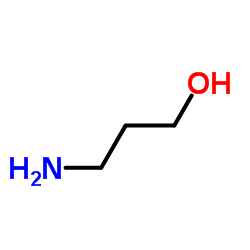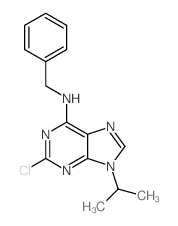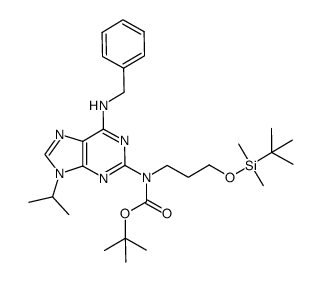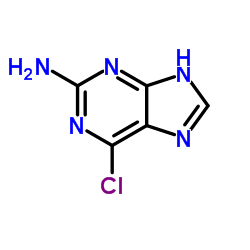Bohemine
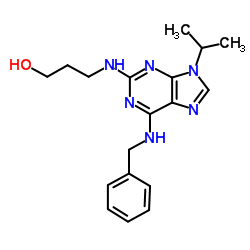
Bohemine structure
|
Common Name | Bohemine | ||
|---|---|---|---|---|
| CAS Number | 189232-42-6 | Molecular Weight | 340.423 | |
| Density | 1.3±0.1 g/cm3 | Boiling Point | 589.4±60.0 °C at 760 mmHg | |
| Molecular Formula | C18H24N6O | Melting Point | N/A | |
| MSDS | Chinese USA | Flash Point | 310.3±32.9 °C | |
Use of BohemineBohemine is a purine analogue and is a synthetic and selective CDK inhibitor with IC50s of 4.6 μM, 83 μM, and 2.7 μM for Cdk2/cyclin E, Cdk2/cyclin A, and Cdk9/cyclin T1, respectively. Bohemine also inhibits ERK2 with an IC50 of 52 μM and has less inhibitory effect on CDK1, CDK4 and CDK6. Bohemine has a broad spectrum anti-cancer activities[1][2]. |
| Name | 3-[[6-(benzylamino)-9-propan-2-ylpurin-2-yl]amino]propan-1-ol |
|---|---|
| Synonym | More Synonyms |
| Description | Bohemine is a purine analogue and is a synthetic and selective CDK inhibitor with IC50s of 4.6 μM, 83 μM, and 2.7 μM for Cdk2/cyclin E, Cdk2/cyclin A, and Cdk9/cyclin T1, respectively. Bohemine also inhibits ERK2 with an IC50 of 52 μM and has less inhibitory effect on CDK1, CDK4 and CDK6. Bohemine has a broad spectrum anti-cancer activities[1][2]. |
|---|---|
| Related Catalog | |
| Target |
CDK2/cyclinE:4.6 μM (IC50) cdk2/cyclin A:83 μM (IC50) CDK9/cyclinT1:2.7 μM (IC50) ERK2:52 μM (IC50) |
| In Vitro | Bohemine (0-30 µM; 72 hours; ME-750 cells) treatment inhibits cell growth. Addition of Bohemine at concentrations in the range of 1-10 µM results in a short-term arrest of growth and of monoclonal antibody production. The short-term suppression of cell functions is followed by a significant temporary increase of specific growth rate and of specific production rate[1]. Hybridoma cells are retarded both at the G1/S boundary and at the G2/M boundary, depending on Bohemine (0-30 µM) concentration[1]. T-lymphoblastic cell line CEM is treated by Bohemine, five proteins are found to be downregulated, namely α-enolase, triosephosphate isomerase, initiation factor 5A, and α- and β-subunits of Rho GDP-dissociation inhibitor 1. These proteins play significant roles in glycolysis, proteosynthesis, and in cytoskeleton rearrangement[1]. Bohemine inhibits growth of human tumor cell lines with an IC50 of 27 µM[2]. Cell Viability Assay[1] Cell Line: Mouse hybridoma ME-750 cells Concentration: 0 µM, 1 µM, 3 µM, 10 µM and 30 µM Incubation Time: 72 hours Result: At 10 µM and 30 µM concentrations, the viable cell count was significantly lower with respect to control, i.e., 77% and 48%, respectively. |
| In Vivo | Bohemine (50 mg/kg; intravenous injection; BALB/c mice) treatment shows Cmax is 72,308 nM, observed clearance is 0.23 L/h and T1/2 is 1.39 h[2]. Animal Model: BALB/c mice bearing the colon 26 murine tumor[2] Dosage: 50 mg/kg Administration: Intravenous injection (Pharmacokinetic Analysis) Result: Cmax is 72,308 nM, observed clearance is 0.23 L/h and T1/2 is 1.39 h. |
| References |
| Density | 1.3±0.1 g/cm3 |
|---|---|
| Boiling Point | 589.4±60.0 °C at 760 mmHg |
| Molecular Formula | C18H24N6O |
| Molecular Weight | 340.423 |
| Flash Point | 310.3±32.9 °C |
| Exact Mass | 340.201172 |
| PSA | 91.12000 |
| LogP | 1.02 |
| Vapour Pressure | 0.0±1.7 mmHg at 25°C |
| Index of Refraction | 1.653 |
| InChIKey | OPQGFIAVPSXOBO-UHFFFAOYSA-N |
| SMILES | CC(C)n1cnc2c(NCc3ccccc3)nc(NCCCO)nc21 |
| Storage condition | -20℃ |
|
Section1. IDENTIFICATION OF THE SUBSTANCE/MIXTURE Product identifiers Product name: Bohemine CAS-No.: 189232-42-6 Relevant identified uses of the substance or mixture and uses advised against Identified uses: Laboratory chemicals, Manufacture of substances Section2. HAZARDS IDENTIFICATION Classification of the substance or mixture Not a hazardous substance or mixture according to Regulation (EC) No 1272/2008 This substance is not classified as dangerous according to Directive 67/548/EEC. Label elements Caution - substance not yet tested completely. Other hazards - none Section3. COMPOSITION/INFORMATION ON INGREDIENTS Substances Synonyms: 2-(3-Hydroxypropylamino)-6-benzylamino-9-isopropylpurine Formula: C18H24N6O Molecular Weight: 340,42 g/mol Section4. FIRST AID MEASURES Description of first aid measures If inhaled If breathed in, move person into fresh air. If not breathing, give artificial respiration. In case of skin contact Wash off with soap and plenty of water. In case of eye contact Flush eyes with water as a precaution. If swallowed Never give anything by mouth to an unconscious person. Rinse mouth with water. Most important symptoms and effects, both acute and delayed Indication of any immediate medical attention and special treatment needed no data available Section5. FIREFIGHTING MEASURES Extinguishing media Suitable extinguishing media Use water spray, alcohol-resistant foam, dry chemical or carbon dioxide. Special hazards arising from the substance or mixture Carbon oxides, nitrogen oxides (NOx) Advice for firefighters Wear self contained breathing apparatus for fire fighting if necessary. Further information no data available Section6. ACCIDENTAL RELEASE MEASURES Personal precautions, protective equipment and emergency procedures Avoid dust formation. Avoid breathing vapors, mist or gas. Environmental precautions Do not let product enter drains. Methods and materials for containment and cleaning up Sweep up and shovel. Keep in suitable, closed containers for disposal. Reference to other sections For disposal see section 13. Section7. HANDLING AND STORAGE Precautions for safe handling Provide appropriate exhaust ventilation at places where dust is formed.Normal measures for preventive fire protection. Conditions for safe storage, including any incompatibilities Store in cool place. Keep container tightly closed in a dry and well-ventilated place. Recommended storage temperature: -20 °C Packaged under inert gas. Air and light sensitive. Specific end uses no data available Section8. EXPOSURE CONTROLS/PERSONAL PROTECTION Control parameters Components with workplace control parameters Exposure controls Appropriate engineering controls General industrial hygiene practice. Personal protective equipment Eye/face protection Use equipment for eye protection tested and approved under appropriate government standards such as NIOSH (US) or EN 166(EU). Skin protection Handle with gloves. Gloves must be inspected prior to use. Use proper glove removal technique (without touching glove's outer surface) to avoid skin contact with this product. Dispose of contaminated gloves after use in accordance with applicable laws and good laboratory practices. Wash and dry hands. The selected protective gloves have to satisfy the specifications of EU Directive 89/686/EEC and the standard EN 374 derived from it. Body Protection Choose body protection in relation to its type, to the concentration and amount of dangerous substances, and to the specific work-place., The type of protective equipment must be selected according to the concentration and amount of the dangerous substance at the specific workplace. Respiratory protection Respiratory protection is not required. Where protection from nuisance levels of dusts are desired, use type N95 (US) or type P1 (EN 143) dust masks. Use respirators and components tested and approved under appropriate government standards such as NIOSH (US) or CEN (EU). Section9. PHYSICAL AND CHEMICAL PROPERTIES Information on basic physical and chemical properties a) AppearanceForm: powder Colour: white b) Odourno data available c) Odour Thresholdno data available d) pHno data available e) Melting point/freezingno data available point f) Initial boiling point and no data available boiling range g) Flash pointno data available h) Evaporation rateno data available i) Flammability (solid, gas) no data available j) Upper/lowerno data available flammability or explosive limits k) Vapour pressureno data available l) Vapour densityno data available m) Relative densityno data available n) Water solubilityno data available o) Partition coefficient: n- no data available octanol/water p) Autoignitionno data available temperature q) Decompositionno data available temperature r) Viscosityno data available s) Explosive propertiesno data available t) Oxidizing propertiesno data available Other safety information no data available Section10. STABILITY AND REACTIVITY Reactivity no data available Chemical stability no data available Possibility of hazardous reactions no data available Conditions to avoid no data available Incompatible materials Strong oxidizing agents Hazardous decomposition products Other decomposition products - no data available Section11. TOXICOLOGICAL INFORMATION Information on toxicological effects Acute toxicity no data available Skin corrosion/irritation no data available Serious eye damage/eye irritation no data available Respiratory or skin sensitization no data available Germ cell mutagenicity no data available Carcinogenicity IARC:No component of this product present at levels greater than or equal to 0.1% is identified as probable, possible or confirmed human carcinogen by IARC. Reproductive toxicity no data available Specific target organ toxicity - single exposure no data available Specific target organ toxicity - repeated exposure no data available Aspiration hazard no data available Potential health effects InhalationMay be harmful if inhaled. May cause respiratory tract irritation. IngestionMay be harmful if swallowed. SkinMay be harmful if absorbed through skin. May cause skin irritation. EyesMay cause eye irritation. Additional Information RTECS: Not available Section12. ECOLOGICAL INFORMATION Toxicity no data available Persistence and degradability no data available Bioaccumulative potential no data available Mobility in soil no data available Results of PBT and vPvB assessment no data available Other adverse effects no data available Section13. DISPOSAL CONSIDERATIONS Waste treatment methods Product Offer surplus and non-recyclable solutions to a licensed disposal company. Contaminated packaging Dispose of as unused product. Section14. TRANSPORT INFORMATION UN number ADR/RID: -IMDG: -IATA: - UN proper shipping name ADR/RID: Not dangerous goods IMDG: Not dangerous goods IATA:Not dangerous goods Transport hazard class(es) ADR/RID: -IMDG: -IATA: - Packaging group ADR/RID: -IMDG: -IATA: - Environmental hazards ADR/RID: noIMDG Marine pollutant: noIATA: no Special precautions for user no data available SECTION 15 - REGULATORY INFORMATION N/A SECTION 16 - ADDITIONAL INFORMATION N/A |
| Personal Protective Equipment | Eyeshields;Gloves;type N95 (US);type P1 (EN143) respirator filter |
|---|---|
| RIDADR | NONH for all modes of transport |
| WGK Germany | 3 |
| HS Code | 2933990090 |
|
~80% 
Bohemine CAS#:189232-42-6 |
| Literature: Institute of Experimental Botany of the Academy of Sciences of the Czech Republic Patent: US6221873 B1, 2001 ; US 6221873 B1 |
|
~88% 
Bohemine CAS#:189232-42-6 |
| Literature: Fletcher, Steven; Shahani, Vijay M.; Gunning, Patrick T. Tetrahedron Letters, 2009 , vol. 50, # 29 p. 4258 - 4261 |
|
~% 
Bohemine CAS#:189232-42-6 |
| Literature: Austin, Richard E.; Okonya, John F.; Bond, Daniel R.S.; Al-Obeidi, Fahad Tetrahedron Letters, 2002 , vol. 43, # 35 p. 6169 - 6171 |
| Precursor 3 | |
|---|---|
| DownStream 0 | |
| HS Code | 2933990090 |
|---|---|
| Summary | 2933990090. heterocyclic compounds with nitrogen hetero-atom(s) only. VAT:17.0%. Tax rebate rate:13.0%. . MFN tariff:6.5%. General tariff:20.0% |
| purine deriv. 1 |
| 3-{[6-(Benzylamino)-9-isopropyl-9H-purin-2-yl]amino}-1-propanol |
| 2-[(3-hydroxypropyl)amino]-6-benzylamino-9-isopropylpurine |
| HMS3229C10 |
| 3-{[6-(benzylamino)-9-(propan-2-yl)-9H-purin-2-yl]amino}propan-1-ol |
| [6-Benzylamino-2-(3-hydroxypropylamino)-9-isopropylpurine |
| 1-Propanol, 3-[[9-(1-methylethyl)-6-[(phenylmethyl)amino]-9H-purin-2-yl]amino]- |
| bohemine |
| 2-(3-Hydroxypropylamino)-6-benzylamino-9-isopropylpurine |
